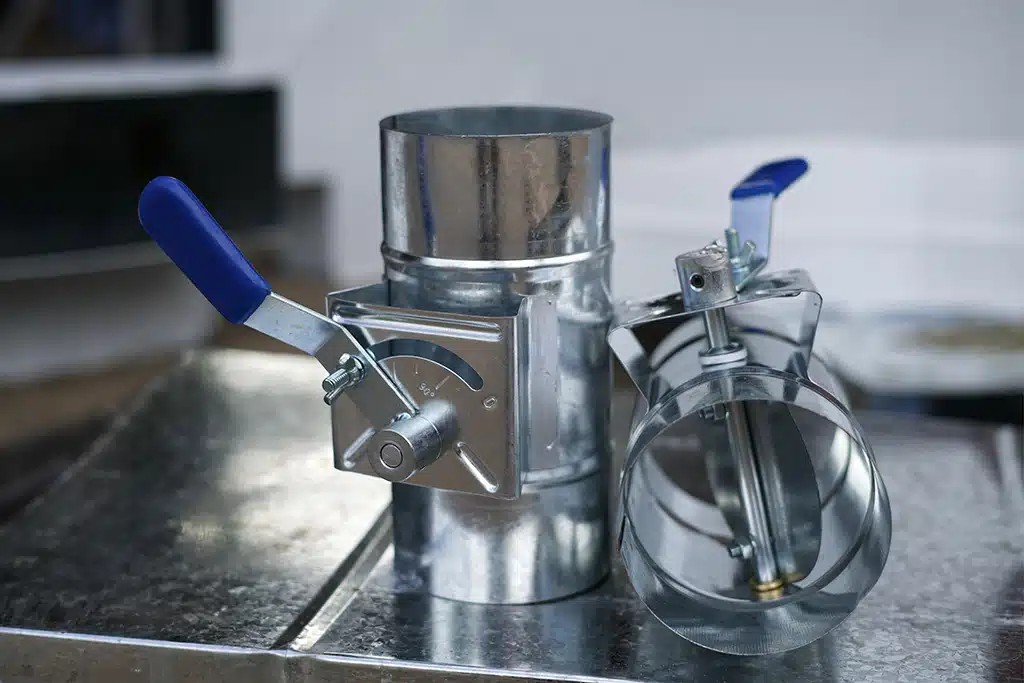
Types Of HVAC Dampers An AC Repair Company Can Install In Your HVAC System | Fort Worth, TX
Commercial users and homeowners alike are constantly looking to improve the efficiency and effectiveness of their heating and air conditioning systems. So naturally, they follow every heating and air conditioning development. Fortunately, there are many ways of improving the efficiency of an HVAC system, and one of them is HVAC zoning. With the development in the heating and air conditioning industry, you can now eliminate any unevenly heated or cooled sections at your Fort Worth, TX home through HVAC zoning. This can be accomplished by having an AC repair company install a damper HVAC system.
With zones, a homeowner can control the volume of air flowing into a particular area of their home and also prevent the areas that aren’t occupied from being heated or cooled. When actualized, this can work wonders and save you a fortune in cooling and heating energy costs while simultaneously maintaining a similar level of comfortability. Although some homeowners only use the vents for controlling the airflow, installing a damper HVAC system can prove a better option, specifically when talking about zoning.
So, how can airflow control in HVAC zoning be achieved? Let’s first go through the various components of an HVAC zoning system that an AC repair company can install.
Parts of a Heating and Air Conditioning Zoning System
In HVAC zoning, your central air conditioner is split into smaller parts. Each piece is tasked with serving a particular area of your indoor setting. To achieve this, you must have certain components as part of your HVAC system. These components include but aren’t limited to smart thermostats, dual-zone thermostats, dampers, and temperature sensors. To find where the sensor is, contact your AC repair company.
The sensors are used for detecting the current temperatures in your indoor space. Your thermostat is a component you use to control your HVAC system’s cooling or heating temperatures. The sensors are normally placed in the thermostat itself. However, in some instances, this is only sometimes the case. The dampers are the final piece of this zoning jigsaw. These essential components block the airflow from coming via the vents into your indoor space where it isn’t needed.
What Are Dampers in an HVAC System
An HVAC damper can be compared to a dam. When closed, a damper prevents air from passing through it, like how a dam restricts the water that flows downstream. A stopper HVAC, commonly referred to as an air duct damper, is a device used to control the airflow in your home. The movable plate is 4-6 feet away from the main air duct trunk. A crucial part of your HVAC zoning system is the HVAC dampers. They serve as duct valves that determine how much heated or cooled air is needed in each room of your house to attain the desired temperature. When they run into an issue, you should have them inspected by an AC repair company.
It allows you to regulate the volume of conditioned air dispersed throughout your house. They should be distinct from the vents installed on the floors or walls. Vents are usually also used to regulate airflow, but they are less effective than HVAC dampers. Air is still available in the duct length even when vents prevent it from entering the room. In contrast, HVAC dampers are close to the air distribution pipe’s opening and can prevent air from entering the ductwork. This will result in uneven cooling or heating, prompting the attention of an AC repair company.
How Do HVAC Dampers Work?
HVAC dampers function like valves, as was already established. They must choose how warm or cooled air should be sent throughout your ducting. The ducting will then adjust the temperature in your zone to the proper level. You can change the direction of the airflow by closing the dampers. In this manner, these elements function to cool or heat a specific area as desired. Dampers are much more effective in rerouting the airflow because they are near the air source than closing the vents. Hence, they should be properly fitted by an AC repair company
Why Should You Install HVAC Dampers?
Dampers allow you to adjust the temperature of each room while leaving the central HVAC system in a single setting. This is particularly helpful if you’re house-sitting for elderly relatives who could feel too warm or too cold in conditions you find comfortable. A room’s inhabitants can regulate the temperature to their preference without impacting the other rooms in the house, thanks to dampers.
If you want to use a place for a long time, this is a necessary piece of technology because maintaining comfortable temperatures has some real health benefits for seniors. Hence, ensure that you have an AC repair company in Fort Worth, TX who comes over to install Dampers to ensure the senior citizenry at your home is comfortable. You can also pair the dampers with a smart thermostat for more comfort and convenience.
Types of HVAC Dampers
Manual HVAC Dampers: These are dampers managed by valves outside the air ducts. They only need to be moved down and up whenever closing or opening a specific damper. Being manual, they are prone to damage, resulting in a need for frequent AC repairs. However, they have a low cost of maintenance, unlike automatic dampers.
Automatic HVAC Dampers: Automatic Air conditioning dampers need a motor to close or open the valves and plates. They also can be remotely controlled. You should have an AC repair company install smart thermostats to ensure that the automatic HVAC dampers work at maximum efficiency. Additionally, you don’t need to worry about weather changes as these dampers can self-regulate. Below Are the various types of HVAC dampers
Butterfly Flat Dish HVAC Dampers
Butterfly flat dish HVAC dampers are made up of a seal, a round blade, and a center hinge. When properly aligned with the ducts, the blade regulates the airflow. The seal prevents material from entering the ductwork by joining the blade edges and the duct’s perimeter. This air duct damper is a good option for preventing fires since it may stop backdrafts by limiting airflow in one direction. They work best with circular ducts. Hence, if you have round air ducts, you should consider having an AC repair company install butterfly flat dish HVAC dampers.
Blade Dampers
Metal plates are the fundamental part of blade dampers. They control the airflow through the chimneys or even the ducts. There are two types of blade dampers: opposing and parallel. Blades in parallel blade dampers move parallel to one another. In contrast, opposed blade dampers move the other way. These two categories function extremely differently from one another. Dampers with parallel blades are the best choice for maintaining airflow.
Conversely, opposing blade dampers are more effective at controlling airflow. They are less noisy than other HVAC dampers and have a better sealing capacity. Hence, if you need your air ducts to run more silently, have an AC repair company in Fort Worth, TX install damper blades.
Guillotine Dampers
An AC repair company can install a guillotine damper anywhere that positive isolation is needed. This is a result of their superior sealing capacity. They can temporarily control airflow in a zoned duct system while your HVAC system is serviced.
Louver Dampers
Louver dampers are the most used air duct dampers in heating and air conditioning systems. Their ability to fit in any duct size is the cause. They have great air-blocking capabilities and are made of thin, flat blades on hinges. If you have narrow ducts, talk to an AC repair company in Fort Worth, TX about installing Louver dampers.
Zone Damper
In a heating, ventilation, and air conditioning (HVAC) system, a zone damper is a particular kind of damper used to regulate airflow. Most of the time, zone dampers in residential HVAC systems are electrically driven. In large corporate buildings, compressed air or vacuum can be employed in its place. In any case, the engine and damper are typically connected via a mechanical coupling. Being a mechanical unit requires frequent air conditioning service from a reliable AC repair company.
Adjusting Dampers
The other half of having HVAC dampers in the home is efficiently managing them. Depending on the seasonal needs for heating or cooling, you should keep your HVAC damper open or closed. If your zoning system is automated, your heating and air conditioning system will take care of these tasks for you, so you won’t need to. To achieve this, you should first choose the HVAC damper. But it may take work. Hence, it is recommended that you consult an AC repair company.
It may be difficult to locate the damper access in older Fort Worth, TX homes because it has been blocked off by walls or paint. If the vents are covered by drywall, you only want to demolish the wall if you wish to use them for zoning your HVAC. The access panel is typically visible and appropriately labeled such that you can identify which room each damper belongs to.
Turning a lever, like a water tap, is all it takes to modulate a damper HVAC. The damper can also be adjusted to only partially open. However, be cautious and ensure you change the right damper, not one for a different area. This confusion can be greatly reduced by closing each damper individually, opening them afterward, and identifying each one. If you cannot identify them, have an AC repair company come over for help.
Here is an instance where changing the dampers can improve your comfort. The lower levels of a homestay are typically cooler because, as we all know, cold air sinks while hot air rises. You can then close the HVAC dampers for the basement level during the summer and only allow air to pass through the upper part. The chilly air will then move downhill on its own. In contrast, warm air rises from the bottom upwards in the summer when the upper floor’s dampers are closed.
Inlet Vane Dampers
Appliances that need a fan shut-off and volume control for the regulated airflow employ inlet vane dampers. Variable inlet vanes and internal vane controls are other names for inlet vane dampers. Pre-spinning the air in the way the fan is moving reduces the fan’s load, lowering pressure and airflow while also consuming less energy. Long-term energy expenses can therefore be decreased by using inlet vane dampers. Hence, if you aim to reduce the heating and cooling bills, an AC repair company can install inlet vane dampers in your air ducts.
Location of HVAC Dampers
The most typical place for HVAC dampers is in the primary trunk line, before and after any significant intersections. Additionally, they can be found at specific locations on various system ducts, having two dampers on each main line spaced 90 degrees apart. Hence, it is recommended that an AC repair company confirm where the dampers are installed in your case. Dampers might differ from one manufacturer to the next and even from one unit to another.
Every home is unique. Some houses don’t even have any dampers. Depending on the location of your Fort Worth, TX home, a supply duct from your furnace may exit to the left or right. Typically, a damper will be installed inside the supply duct leading to your upper floor. If your ducts are exposed, ensure that the AC repair company checks each run to see if any have dampers. Some homes have dampers in each run, which is great for balancing the air.
An air conditioner repair technician may install different types of HVAC dampers at your home. However, there are factors that the professional has to consider before purchasing and installing them. Do you want HVAC Dampers installed in your Fort Worth, TX, home? Contact us at One Hour Air Conditioning & Heating of Fort Worth, your reliable AC repair company.


